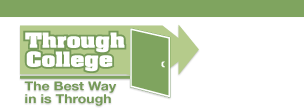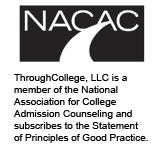The
ThroughCollege System helps
individual students find, apply to, and succeed at their best-fit college. The 4 Steps of the ThroughCollege System are a series of innovative and engaging activities students can do on their own or with a mentor.

College Preparation & Educator Resources
ThroughCollege Research
Reports
Thinking Differently About College
Counseling
Author: Helen Janc Malone, Harvard University
Role of Parents in Students' College Choice
Author: Helen Janc Malone, Harvard University
Innovating College Guidance
Author: Darin Eich, Ph.D., University of Wisconsin
Innovating College Guidance
Part II: Utilizing the Internet for Positive Youth Development
Author: Darin Eich, Ph.D., University of Wisconsin
ThroughCollege Blog Articles
Authors: ThroughCollege Fellows
College
Guidance Resources
Events
American School Counselor Association Annual Conference (http://www.schoolcounselor.org/content.asp?pl=325&sl=129&contentid=182)
College Summit Institute (http://www.collegesummit.org/school-districts/teachers-and-counselors/training-and-support/college-summit-institute-2008/)
National College Access Network Annual Conference (http://www.collegeaccess.org/NCAN/ItemPage.aspx?groupid=2853&id=3222)
National Organizations
American
School Counselor Association (http://www.schoolcounselor.org/)
College Summit (http://www.collegesummit.org/)
Higher Education Information Center, The Education Resources Institute (http://www.tericollegeplanning.org/)
National Association for College Admission Counseling (http://www.nacacnet.org)
National College Access Network (http://www.collegeaccess.org/NCAN/)
Pathways to College Network (http://www.pathwaystocollege.net/)
Guides for High School Students
American College Testing Service (ACT) (http://www.act.org)
College Board/SAT (http://www.collegeboard.com)
CollegeMotivation (http://www.collegemotivation.com)
College Tours (http://www.campustours.com/)
Common Application (http://www.commonapp.org)
E-Campus Tours (http://www.ecampustours.com/default.htm)
Edvisors (http://www.edvisors.com/)
FAFSA
(http://www.fafsa.ed.gov)
Getting Ready for College (planning guide from TERI) (http://www.teri.org/pdf/loan-center/Get_Ready_For_College_english.pdf)
KnowHow2Go (http://www.knowhow2go.com)
The
Princeton Review (http://www.princetonreview.com)
What's My Calling? (Facebook Career or Major Discovery Activity) (http://apps.facebook.com/whatsmycalling)
Guides for Counselors
Advisor Training Module (from NCAN) (http://www.collegeaccess.org/ncan/uploads/advisortrainingmodule.pdf)
Guide
to Creating Community-Based College Access Centers (http://www.collegeaccess.org/NCAN/Uploads/2007083134CollegeAccessCenters.pdf)
The
ASCA National Model (ASCA Framework) (http://www.schoolcounselor.org/files/Natl%20Model%20Exec%20Summary_final.pdf)
Research institutes
Institute for Higher Education Policy (http://www.ihep.org/)
NCHEMS
Information Center for State Higher Education Policymaking and Analysis (http://www.higheredinfo.org/)
Southern Regional Education Board (http://www.sreb.org/)
The
Education Resources Institute (http://www.teri.org/)
The
National Center for Public Policy and Higher Education (http://www.highereducation.org/)
The
Pell Institute for the Study of Opportunity in Higher Education (http://www.pellinstitute.org/)
The
Stanford Institute for Higher Education Research (http://siher.stanford.edu/)
USC
Rossier School of Education (http://www.usc.edu/dept/education/)
WISCAPE (http://www.wiscape.wisc.edu/)
National Research
Ascher, C ., & Maguire, C. (2007, December). Beating the odds.
Providence, RI: Annenberg Institute for School Reform at Brown
University. (http://www.annenberginstitute.org/Products/BTO.php)
Bedsworth, W., Colby, S., & Doctor, J. (2006, October). Reclaiming the
American dream. The Bridgespan Group. (http://www.bridgespangroup.org/PDF/ReclaimingtheAmericanDreamWhitePaper.pdf)
Bottoms, G., & Young, M. (2008). Lost in translation: Building a better
path for school to college and careers. Atlanta, GA: Southern Regional
Educational Board.
Choy,
S. P. (2002). Access & persistence: Findings from 10 years of
longitudinal research on students. Washington,
DC: American Council on Education, Center for Policy Analysis. (http://www.acenet.edu/bookstore/pdf/2002_access)
Corwin, Z. B., & Tierney, W. G. (2007, January). Getting there and
beyond: Building a culture of college-going in high schools. USC Center
for Higher Education Policy Analysis. (http://www.usc.edu/dept/chepa/working/Getting%20There%20FINAL.pdf)
Dounay, J. (2006, August). Involving Families in High School and College
Expectations. ECS Policy Brief. (http://www.ecs.org/clearinghouse/70/37/7037.pdf)
Engle, J., Bermeo, A., & O’Brien, C. (2006, December). Straight from the
source: What works for first-generation college students. Washington,
DC: The Pell Institute for the Study of
Opportunity
in Higher Education.
http://www.pellinstitute.org/
Gandara, P., & Bial, D. (2006). Paving the way to postsecondary
education: K-12 intervention programs for underrepresented youth.
Washington DC: National Postsecondary Education Cooperative, U.S. Department
of Education.
http://nces.ed.gov/pubs2001/2001205.pdf
Institute for Higher Education Policy. (2006, June). Expanding access and
opportunity: The impact of the Gates Millennium Scholars Program.
Washington, DC: Author. (http://www.immagic.com/eLibrary/ARCHIVES/GENERAL/IHEP_US/I060615E.pdf)
Malveaux, J. (2003, January). What’s at stake: The social and economic
benefits of higher education. Research Report 2. National Dialogue on
Student Financial Aid. (http://www.collegeboard.com/prod_downloads/about/news_info/natdial/RR2_social_econ.pdf)
Martinez,
M., & Klopott, S. (2003). Improving college access for minority,
low-income, and first-generation students. Washington, DC: Institute for Educational Leadership and the National
Clearinghouse for Comprehensive School Reform. (http://www.prel.org/products/pr_/compendium04/KlopottMartinez.htm)
McSwain, C., & Davis, R. (2007, July). College access for the working
poor: Overcoming burdens to succeed in higher education. Washington, DC:
Institute for Higher Education Policy. (http://www.insidehighered.com/news/2007/07/10/poor)
Roderick, M., Nagaoka, J., Coca, V., & Moeller, E. (2008, March). From
high school to the future: Potholes on the road to college. Chicago, IL:
Consortium on Chicago School Research at the University of Chicago. (http://ccsr.uchicago.edu/downloads/1835ccsr_potholes_summary.pdf)
Ruppert, S. S. (2003, October). Closing the college participation gap: A
national summary. Denver,
CO: Center for Community College Policy, Education Commission of the States.
(http://www.ecs.org/clearinghouse/47/84/4784.pdf)
State
Higher Education Executive Officers. (2003). Student success: Statewide
P-16 systems. Denver,
CO: Author.
http://www.sheeo.org/k16/P16.pdf
The
National Center for Higher Education Management Systems and Jobs for the
Future. (2007, November). Adding it up: State challenges for increasing
college access and success. Washington, DC: Author. (http://www.makingopportunityaffordable.org)
Venezia, A., Kirst, M. W., & Antonio, A. L. (n.d.). Betraying the college
dream: How disconnected K-12 and postsecondary education systems undermine
student aspirations. Final Policy Report from Stanford University’s
Bridge Project. Stanford, CA: The Stanford Institute for Higher Education
Research. (http://www.stanford.edu/group/bridgeproject/betrayingthecollegedream.pdf)
Wimberly, G. L., & Noeth, R. J. (2005). College readiness begins in
middle school. ACT. (http://www.act.org/research/policymakers/pdf/CollegeReadiness.pdf)
Wimberly, G. L., & Noeth, R. J. (2004). Schools involving parents in
early postsecondary planning. ACT. (http://www.act.org/research/policymakers/pdf/involve_parents.pdf)
News
Chronicle of Higher Education (http://chronicle.com/)
EdWeek (http://www.edweek.org)
Inside Higher Ed (http://www.insidehighered.com/)
|





